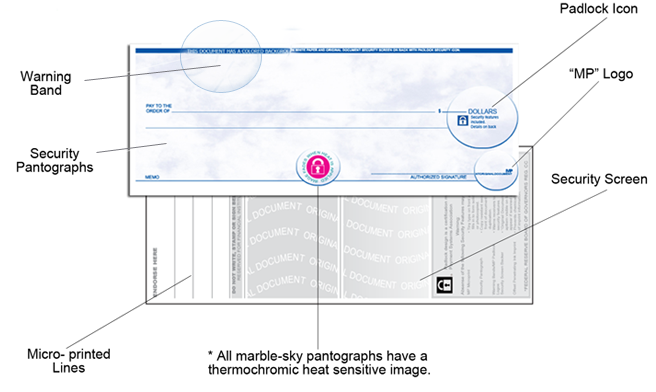

Optionally, the security mark may be a pantograph mark in which the foreground includes a first pattern of dots and the background comprises a second pattern of dots. Optionally, when printing the security mark, the print device may print the foreground and the background at substantially equal sizes. When displaying the image, the display may do so a second color space, such as in an RGB color space. When printing the second document, the print engine may do in first color space such as a CMY color space. The non-infrared-absorbing colors in each pattern of the first substrate may exclude black. The second pattern also may include C, M, Y, CM, CY and/or MY. When printing the second pattern the print device will use a CMY ink combination. The non-infrared-absorbing colors of the second pattern may include CMY. The non-infrared-absorbing colors of the first pattern may include any or all of the following: C, M, Y, CM, CY or MY, and when printing the first pattern the print device may use any of following ink combinations: C, M, Y, CM, CY or MY. However, when the print engine prints the copy of the security mark on the second substrate, the print engine will use at least some infrared-absorbing ink to do so. When the print device prints the security mark on the first substrate, the print device may use no infrared-absorbing ink to do so. The displayed image will include a watermark that is visibly different from other portions of the image on the display. The system also may include an infrared camera, a display, and additional programming instructions that are configured to cause a processor (which may or may not be the same as the previous processor) to, upon receipt of an image of the security mark on the second substrate captured by the infrared camera, cause the display to display the image captured by the infrared camera. The system also may include a print engine and additional instructions to cause the print engine to create a copy of the security mark and printing the copy on a second substrate. The system will cause the print device to print a security mark on a first substrate in a first color space by: (a) printing either the first pattern or the second pattern as a foreground, and (ii) printing the other of the pattern as a background. The first pattern and the second pattern will exhibit substantially the same color, substantially the same pattern (i.e., size and shape of objects in the image), as well as substantially the same reflectance in the infrared spectrum. To do this, the system will select a first pattern that includes one or more non-infrared-absorbing colors, and it will select a second pattern that also includes one or more non-infrared-absorbing colors. In various embodiments, a document security marking system includes a print device, a processor, and a computer-readable medium containing programming instructions that are configured to cause the process to print security mark on a substrate. This document describes methods and systems for creating a pantograph mark that addresses at least some of the problems described above, and/or other problems. However, due to the very small holes required to take advantage of the scanner's modulation transfer function (MTF) can degrade image quality and increase fragility of the watermark. However, when a color copy 12 of the original document is printed, the word “VOID” is visible to the unaided human eye in the color copy 12.Īn advantage of UV void pantographs is that a counterfeiter will not likely see the watermark the watermark will only appear when inspected under UV light. The security mark shown in the example includes the word “VOID,” but this word is not visible to the human eye in the original document 11. 1, in which an original document 11, such as a bank check, has a security mark printed on it. The features of pantograph marks will be described below, but by way of example it is common to print a “void” pantograph mark on a document so that certain content of the security mark is not visible to the unaided human eye on the original, but the content will be visible on a copy of the original. An example of such a mark is a pantograph mark.

For example, financial instruments such as checks, event admission tickets and other documents for which it is important to visually distinguish the original from a copy may include such security marks. In some situations, document creators may wish to encode a security mark in a document in a way that is invisible to the human eye, but which becomes visible when the document is copied. In situations such as official or government document printing, event ticket printing, financial instrument printing and the like, many printed materials must be protected against copying, forging and/or counterfeiting. Security is an important requirement in many printing applications.


 0 kommentar(er)
0 kommentar(er)
